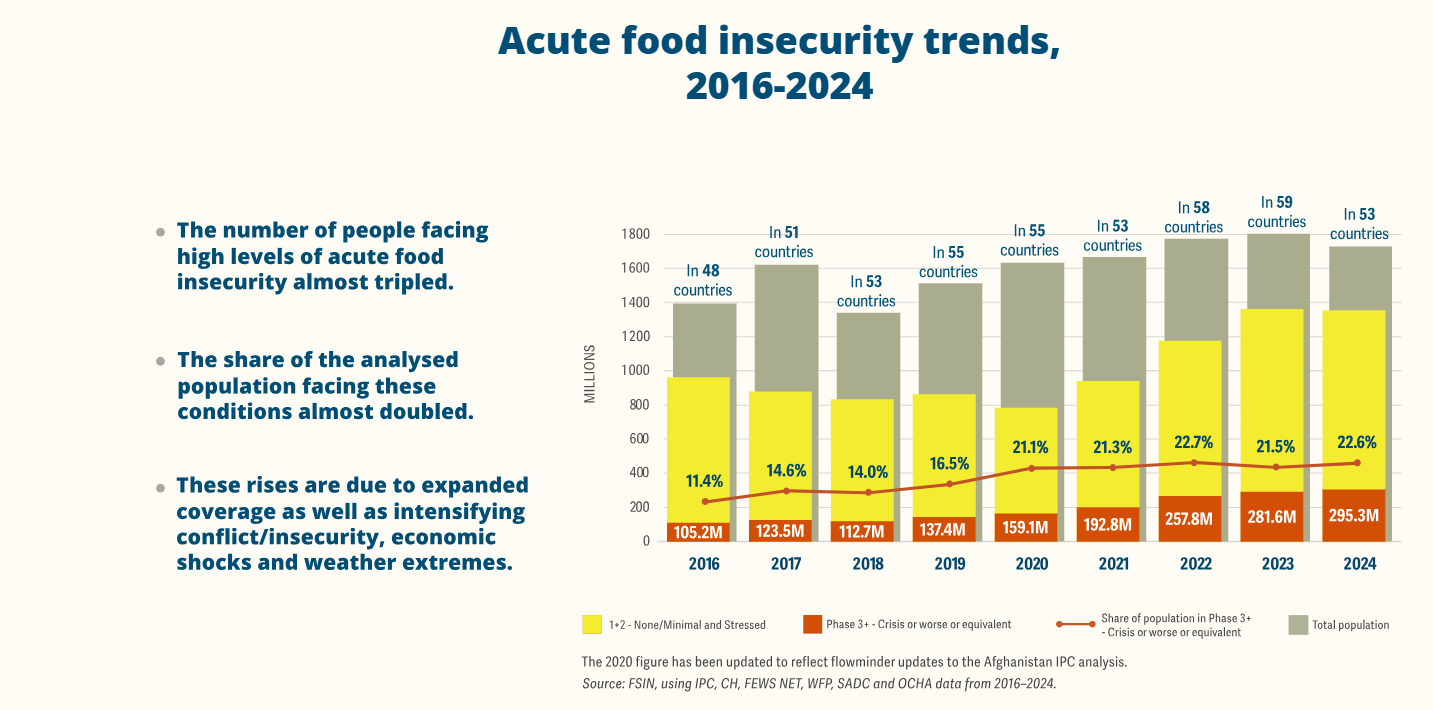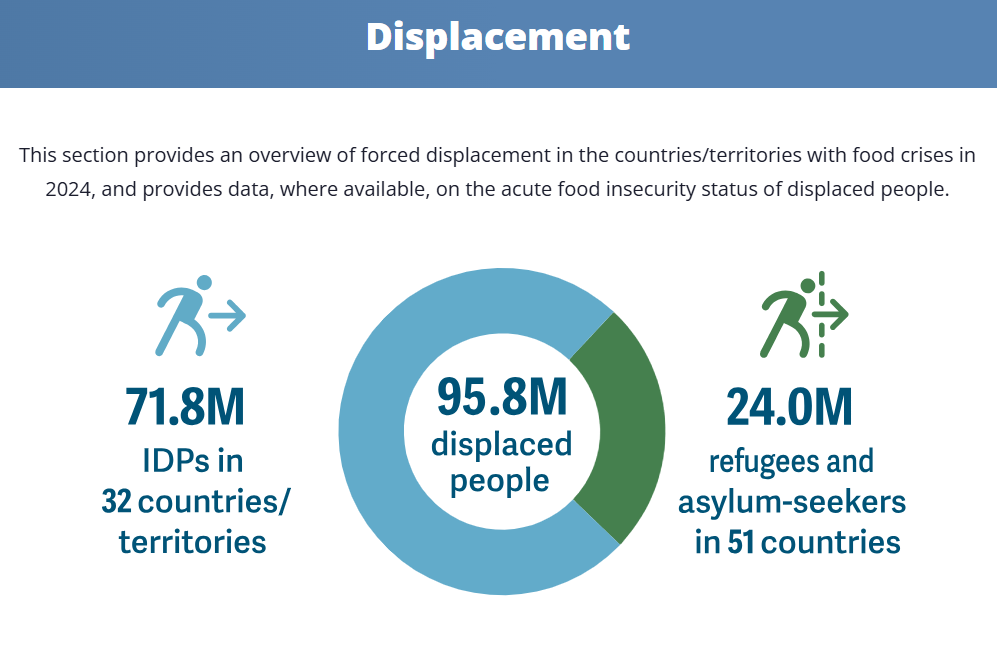Social Issues
Global Report on Food Crises 2025
- 20 May 2025
- 10 min read
For Prelims: Global Network Against Food Crises (GNAFC), Food Security Information Network (FSIN), Global Report on Food Crises (GRFC), Malnutrition, Acute Food Insecurity, El Nino, United States Agency for International Development (USAID).
For Mains: Status of severity of acute food insecurity and nutrition crisis (malnutrition) worldwide, Causes and way forward for tackling acute food insecurity and nutrition crisis (malnutrition).
Why in News?
The Global Report on Food Crises (GRFC) 2025 has revealed that more than 295 million people across 53 countries experienced acute hunger, an increase of 13.7 million compared to 2023.
- The report highlights a deepening global food insecurity crisis fueled by ongoing conflicts, severe climate events, economic disruptions, and forced displacement.
Global Report on Food Crises (GRFC)
- The Global Report on Food Crises (GRFC), 2025 has been published by the Global Network Against Food Crises (GNAFC) in collaboration with the Food Security Information Network (FSIN) .
- The GRFC is an annual publication that provides a comprehensive analysis of acute food insecurity and nutrition crisis (malnutrition) worldwide.
- Acute food insecurity occurs when disruptions in food availability, access, utilization, or stability threaten lives or livelihoods.
- A nutrition crisis arises when factors like food scarcity, disease, conflict, and poor healthcare lead to high acute malnutrition in children aged 6–59 months.
What are the Key Drivers of Food Insecurity as per GRFC 2025 Report?
- Conflict & Displacement: Conflict drives food insecurity in 20 countries, affecting 139.8 million people and causing most Catastrophe ( Integrated Food Security Phase Classification (IPC)- 5 i.e., starvation, death, or severe malnutrition) cases, especially in Nigeria, Sudan, and Myanmar.
- Additionally, global acute malnutrition cases in the top 10 affected countries rose from 26.9 million in 2023 to 30.4 million in 2024, with the worst crises in Sudan, and Gaza.
- Extreme Weather Event & Displacement: Rising temperatures, floods, and El Nino caused crop failures, damaging food supply and increasing malnutrition risks.
- It has fueled food insecurity in 18 countries, affecting 96.1 million people, while in 2024, 95.8 million displaced individuals—75% internally displaced—resided in the 53 food-crisis countries.
- Economic Shocks: It drives food insecurity in 15 countries (e.g., South Sudan), affecting 59.4 million people by disrupting incomes, jobs, and food supply chains, leading to higher food prices, lower purchasing power, and reduced access to nutritious food.
- Funding Cuts: The abrupt end of United States Agency for International Development (USAID) funding in 2025 has hit humanitarian efforts risking severe malnutrition and death for 14 million children in Afghanistan, DRC, Ethiopia, Haiti etc.
- Weak Governance: Food insecurity drivers worsen existing vulnerabilities like weak health systems, fragile economies, and political instability, while poor data limits effective response and monitoring.
What are the Socio-Economic Implications of Food Crises on Global Development?
- Poverty Intensification: Food crises disrupt local agro-economies, especially where agriculture dominates, and rising food prices fuel inflation, reducing low-income purchasing power.
- Human Capital Loss: Food crises severely impact nutritional outcomes, especially among children and pregnant women, with over 735 million people chronically undernourished globally as per Global Hunger Index 2023.
- Nutrition-related factors contribute to about 45% of deaths in children under 5 years of age.
- Social Instability: Food shortages often trigger civil unrest and contribute to forced migration. The United Nations High Commissioner for Refugees (UNHCR) reports 23.5 million climate-displaced individuals, many of whom flee due to crop failure and food insecurity.
- Gender Inequality: Food crises disproportionately affect women, who are often responsible for household nutrition but have less access to land, credit, and aid.
- As per UN Women, it is estimated that 60% of chronically hungry people are women and girls.
- Impairment of Educational Systems: Children affected by food crises often experience higher dropout rates due to hunger or the need to support household incomes.
- While the global number of out-of-school children fell by 9 million from 2015-2021, it has increased by 6 million since then, due to stagnation worldwide in food supply.
How can Food Insecurity and Nutrition Crises be Addressed?
- Nutrition Information Systems: Strong early warning systems allow needs of vulnerable groups to be anticipated and addressed before they become severe and widespread.
- For instance, strong early warning systems contributed to preventing famine (IPC Phase 5) in Somalia in 2022–2023.
- Integrated Food Security: Develop comprehensive food security and nutrition systems at country and regional levels, using combined agricultural and livelihood data to identify vulnerable groups, understand shocks, and tailor assistance.
- Increase emergency agricultural aid, which receives only 3% of humanitarian food funding (2016-2024).
- Climate Resilience: Improving agricultural productivity, building conflict-resilient supply chains, and adopting climate-smart farming together reduce vulnerability and support economic recovery amid shocks.
- Link food security with peacebuilding, protect farmers and markets in conflict zones, and rebuild rural economies to reduce hunger from displacement.
- Agrifood Systems Transformation: Investing in agriculture can improve diet affordability, food production, and supply chains, crucial for severely food insecure countries with protracted food crises where most people depend on farming.
- Improve nutrition by expanding therapeutic feeding, fortifying staples, and promoting dietary diversity.
Conclusion
The GRFC 2024 report highlights a worsening global hunger crisis, driven by conflict, climate shocks, and economic instability. With 295 million facing acute food insecurity and funding cuts threatening aid, urgent action is needed—scaling climate-resilient agriculture, strengthening nutrition programs, and boosting humanitarian support—to break the cycle of hunger and malnutrition.
|
Drishti Mains Question: What are the key drivers of acute food insecurity globally, and how do conflict and climate change exacerbate this crisis? Discuss with examples. |
UPSC Civil Services Examination Previous Year Question (PYQ)
Prelims
Q. With reference to the provisions made under the National Food Security Act, 2013, consider the following statements: (2018)
- The families coming under the category of ‘below poverty line (BPL)’ only are eligible to receive subsidised food grains.
- The eldest woman in a household, of age 18 years or above, shall be the head of the household for the purpose of issuance of a ration card.
- Pregnant women and lactating mothers are entitled to a ‘take-home ration’ of 1600 calories per day during pregnancy and for six months thereafter.
Which of the statements given above is/are correct?
(a) 1 and 2 only
(b) 2 only
(c) 1 and 3 only
(d) 3 only
Ans: (b)
Q. The FAO accords the status of ‘Globally Important Agricultural Heritage System (GIAHS)’ to traditional agricultural systems. What is the overall goal of this initiative? (2016)
- To provide modern technology, training in modern farming methods and financial support to local communities of identified GIAHS so as to greatly enhance their agricultural productivity.
- To identify and safeguard eco-friendly traditional farm practices and their associated landscapes, agricultural biodiversity and knowledge systems of the local communities.
- To provide Geographical Indication status to all the varieties of agricultural produce in such identified GIAHS.
Select the correct answer using the code given below:
(a) 1 and 3 only
(b) 2 only
(c) 2 and 3 only
(d) 1, 2 and 3
Ans: (b)
Mains
Q. How far is the Integrated Farming System (IFS) helpful in sustaining agricultural production? (2019)









